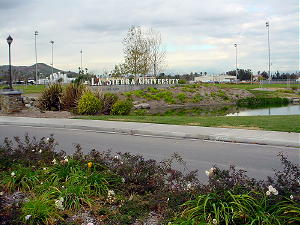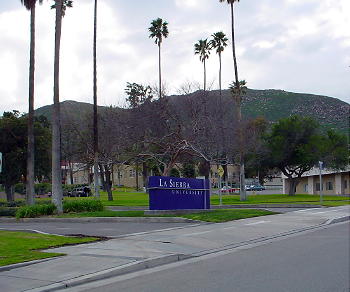An Article In Meteorite-Times Magazine
by Robert Verish
![]()
An Article In Meteorite-Times Magazine
by Robert Verish
Meteorites Stolen from Museum - February 2007
Still no sign of these meteorites that were stolen over a year ago.
WARNING to meteorite collectors -- Be on the look-out for three specimens that were stolen from a museum in Riverside, California. (Description of the items to follow below.) These items may have already appeared in auctions, or have been offered for trade, or have already been put-up for sale on the open market.
The World Museum of Natural History is located on the campus of the La Sierra University at Riverside, California. This museum can trace its roots back to the University's original "teaching collections" that the natural sciences department used for classroom activities. These collections grew and grew with each additional donation to the University. The museum was officially founded in 1968 when a very large donation was made. Twenty years later the E.E. Cossentine Hall was built to house these collections. It is still the current location on campus for this museum.
Click on the images below in order to see enlarged versions of these images :


The campus of the La Sierra University at Riverside, California.
"Intellectual pursuits are facilitated by the University Library, museums, Observatory, Arboretum, Brandstater Art Gallery, MICOL computing laboratory, Learning Support and Testing Center, Hancock and Stahl Science Centers, and other campus resources. Physical fitness is encouraged on campus by such diverse activities as intramural and varsity sports, physical education courses, and by three swimming pools, a fitness center, and tennis, basketball, and volleyball courts.
"The University buildings are on a gentle slope looking eastward over the Riverside valley, with its world-famous citrus and walnut groves and its palm-lined boulevards. The approximately 100 acres owned by the University allow, during the winter months, the snow-clad peaks of the surrounding ranges to be seen rising above the rolling open fields--a view of rare beauty from the campus, truly a scenic part of the Inland Empire."
Click on the image, below, in order to see an enlarged version of that image:

Displays of birds from most areas of the world. The Southeast Asian Bird display is the largest of its kind in the U.S.
Systematic displays of unique mammals of the world, including displays of primates and carnivores.
Displayed are selected specimens from one of the largest collections of spheres.
The Mineral displays are regularly changed and updated. Displays typically include the following: minerals of California, meteorites and tektites, fluorescent minerals, along with a display of especially showy minerals.
More than 100 species of trees have been naturalized to the campus which is officially recognized as an arboretum.
Study collections of petrified wood, especially from the western United States.
Now that I've clearly shown that the WMNH is a very reputable museum, and that its collection is very substantial, there is something that I have to explain about the current condition of their meteorite collection. Nearly the entire meteorite collection was donated to the University by Dr. Berwyn Allen. There is no doubt that this collection was catalogued and that, at least at the time it was donated to the museum, an inventory list must have existed. It's possible that this catalog or inventory list stayed with the donor (Dr. Allen), but over the intervening decades, not only did the donor pass away, but so did his son, as well as, the museum's curator of the meteorite collection.
The remaining curators at the WMNH have had to stand-in as "acting curators" for the meteorite collection, but worse, they don't have the benefit of a catalog or inventory list. Although the collection appears on the WMNH website, there is no image gallery for each of the meteorites. As a result there are some meteorites that aren't recorded on an image or a photo. Coupled with the lack of an inventory list and the lack of specimen information, such as size, shape, or weight, there is very little data or information regarding these missing-stolen meteorite items
Although there is a website on the Internet that shows the remainingmeteorites in the collection at the WMNH, unfortunately the images that were, at one time, depicted on Eric Wichman's Meteorite Watch web page, were taken after the theft from the museum.
Click on the image, below, in order to see a similar-shaped slice of Zagami:
The above image is from the Museum's own website. It depicts the small slice of Zagami perched on a square block of leucite (in the middle of the image) roughly in the same arrangement before it was stolen, but without any labels. This is the only image we have of this still-missing specimen.
If you "click" on the image below to see the enlarged version, you'll see both the label AND the "Description" for the Zagami specimen (the sign is behind the slice of Eucrite). The Zagami specimen is still missing from its leucite stand (which is in front of the label).
There are no close-up images of the Zagami meteorite specimen that was stolen from the museum. In order to have a better idea what this specimen of Zagami might look like, there are various OTHER SPECIMENS of similar-looking pieces on EBAY and OTHER recent auctions.
Click on the image, below, in order to see more images of small specimens of the Zagami Martian Meteorite:
There are no close-up images of the Zagami meteorite that was stolen from the WMNH display case. If you "click" on the image above you will be redirected to a list of completed eBay auctions for various Zagami specimens (which are unrelated to the Museum's stolen specimen) where you can see images of other, similarly small-sized specimens of the Zagami meteorite.
There are no images of the Ensisheim meteorite specimen that was stolen from the WMNH display case. If you "click" on the image below you will be redirected to a web page with a description for the Ensisheim meteorite where you can see an image of another similar-sized specimen of the Ensisheim meteorite.
If you "click" on the image below you will be redirected to a list of completed eBay auctions for various Ensisheim specimens (which are unrelated to the Museum's stolen specimen) where you can see images of other similar-sized specimens of the Ensisheim meteorite.
There are no images of the Ensisheim meteorite specimen that was stolen from the WMNH display case. If you "click" on the image above you will be redirected to a list of completed eBay auctions for various Ensisheim specimens (which are unrelated to the Museum's stolen specimen) where you can see images of other, similar-sized specimens of the Ensisheim meteorite.
Click on each of the images, below, in order to see the original versions of those images:
The above image is from the Museum's own website. It depicts the two blades/spear-points that were taken. This is the only image we have of these still-missing meteorite-related artifacts.
If you "click" on the image below, you will be redirected to a list of completed eBay auctions for various blade artifacts (which are unrelated to the Museum's stolen specimens) where you can see images of other, similar-looking blades and spear-points.
If you have information pertaining to the theft or whereabout of these meteorite-related items from the WMNH collection, you can make an anonymous report to the collection manager on this link:
"http://www.lasierra.edu/centers/wmnh/ Info-Request.htm" - Which is also their "WMNH Contact Us" web page.
If you have information regarding any other Missing, Lost and Stolen Meteorites and Tektites that you would like to report and have posted on the Internet, you can contact the The Meteorite Exchange, Inc. with an email to:
To make sure you can view the photographs on this website properly,
make sure that you can see all the shades of gray in the gradient below.
[best viewed at 1024x768 on reflective-coated LCD screens]

The following "references" are used in this article:
My previous articles can be found *HERE*
For for more information, please contact me by email:
Bolide*chaser
